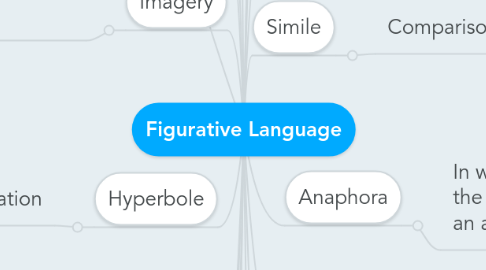
1. Apostrophe
1.1. Discourse
1.1.1. Initimate
1.1.2. Non-Existent
1.1.3. Abstract
2. Metaphor
2.1. Metaphor is a figure of speech which makes an implicit, implied or hidden comparison between two things that are unrelated but share some common characteristics.
2.1.1. My brother was boiling mad. (This implies he was too angry.)
2.1.2. Her voice is music to his ears. (This implies that her voice makes him feel happy)
3. Onomatopoeia
3.1. Onomatopoeia is defined as a word, which imitates the natural sounds of a thing.
3.1.1. Moo-Moo
3.1.2. Meow-Meow
4. Hyperbole
4.1. Exaggeration
4.1.1. Your suitcase weighs a ton!
4.1.2. am trying to solve a million issues these days.
5. Allusion
5.1. Allusion is a brief and indirect reference to a person, place, thing or idea of historical, cultural, literary or political significance.
5.1.1. “Don’t act like a Romeo in front of her.”
5.1.2. “Stop acting like my ex-husband please.”
6. Idiom
6.1. An interesting fact regarding the device is that the expression is not interpreted literally.
6.1.1. “Every cloud has its silver lining but it is sometimes a little difficult to get it to the mint.”
6.1.2. “American idioms drive me up the hall!”
7. Imagery
7.1. objects, actions and ideas in such a way that it appeals to our physical senses.
7.1.1. It was dark and dim in the forest. – The words “dark” and “dim” are visual images.
7.1.2. The girl ran her hands on a soft satin fabric. – The idea of “soft” in this example appeals to our sense of touch or tactile sense.
8. Symbolism
8.1. Different forms
8.1.1. The dove is a symbol of peace.
8.1.2. Black is a symbol that represents evil or death.
9. Consonance
9.1. repetition
9.1.1. The ship has sailed to the far off shores.
9.1.2. Shelley sells shells by the seashore.
10. Metonymy
10.1. It is a figure of speech that replaces the name of a thing with the name of something else with which it is closely associated.
10.1.1. England decides to keep check on immigration. (England refers to the government.)
10.1.2. Let me give you a hand. (Hand means help.)
11. Alliteration
11.1. It is a stylistic device in which a number of words, having the same first consonant sound, occur close together in a series.
11.1.1. Dunkin’ Donuts
11.1.2. Coca-Cola
12. Simile
12.1. Comparison
12.1.1. as
12.1.2. like
13. Personification
13.1. a thing, an idea or an animal is given human attributes.
13.1.1. The wind whispered through dry grass.
13.1.2. The flowers danced in the gentle breeze.
14. Assonance
14.1. Assonance takes place when two or more words close to one another repeat the same vowel sound but start with different consonant sounds.
14.1.1. The engineer held the steering to steer the vehicle.
14.1.2. Go and mow the lawn.
15. Irony
15.1. Verbal irony and situational irony.
15.1.1. The butter is as soft as a marble piece.
15.1.2. “Oh great! Now you have broken my new camera.”
16. Sarcasm
16.1. Sarcasm often depends upon the voice tone
16.1.1. Self-Deprecating Sarcasm – This category of sarcasm expresses an overstated sense of inferiority and worthlessness.
16.1.2. Raging Sarcasm – This kind of sarcasm relies mainly on exaggeration and violent threats.
17. Litotes
17.1. Employs an understatement by using double negatives or, in other words, positive statement is expressed by negating its opposite expressions.
17.1.1. The ice cream was not too bad.
17.1.2. Your comments on politics are not useless.
18. Anaphora
18.1. In writing or speech, the deliberate repetition of the first part of the sentence in order to achieve an artistic effect is known as Anaphora.
18.1.1. “Every day, every night, in every way, I am getting better and better”
18.1.2. “I want my money right now, right here, all right?”
19. Tautology
19.1. Tautology is a repetitive use of phrases or words which have similar meanings. In simple words, it is expressing the same thing, an idea or saying two or more times.
19.1.1. “Repeat that again” and “reiterate again” To repeat or reiterate something is to do or say something again.
19.1.2. ”Your acting is completely devoid of emotion.” Devoid is defined as “completely empty”. Thus, completely devoid is an example of Tautology.
20. Ambiguity
20.1. Ambiguity or fallacy of ambiguity is a word, phrase, or statement which contains more than one meaning.
20.1.1. A good life depends on a liver – Liver may be an organ or simply a living person.
20.1.2. The passerby helps dog bite victim – Is the passerby helping a dog bite someone? Or is he helping a person bitten by a dog? It’s not clear.

